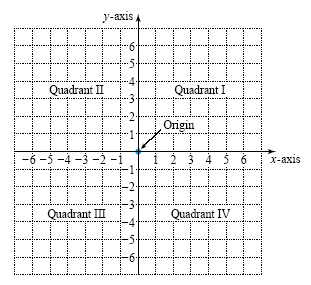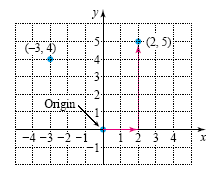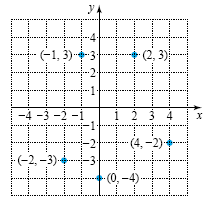|
Plotting Points in the Coordinate PlaneOrdered PairsAn equation in two variables, such as y = 2x + 3, is satisfied only if we find a value for x and a value for y that make it true. For example, if x = 4 and y = 11, then the equation becomes 11 = 2 · 4 + 3, which is a true statement. We write x = 4 and y = 11 as the ordered pair (4, 11). The order of the numbers in an ordered pair is important. For example, (5, 13) also satisfies y = 2x + 3 because using 5 for x and 13 for y gives 13 = 2 · 5 + 3. However, (13, 5) does not satisfy this equation because 5 ≠ 2 · 13 + 3. In an ordered pair the value for x, the x-coordinate, is always written first and the value for y, the y-coordinate, is second: (x, y).
Example 1 Writing ordered pairs Complete the following ordered pairs so that each ordered pair satisfies the equation 4x + y = 5. a) (-2, ) b) ( , 3) Solution a) Replace x with -2 in 4x + y = 5 because the x-coordinate is -2:
So the y-coordinate is 13 and the ordered pair is (-2, 13). b) Replace y with 3 in 4x + y = 5 because the y-coordinate is 3:
So the x-coordinate is
Plotting PointsTo graph ordered pairs of real numbers, we need a new coordinate system. The rectangular or Cartesian coordinate system consists of a horizontal number line, the x-axis, and a vertical number line, the y-axis, as shown in the figure below. The intersection of the axes is the origin. The axes divide the coordinate plane, or the xy-plane, into four regions called quadrants. The quadrants are numbered as shown in the figure below, and they do not include any points on the axes.
Just as every real number corresponds to a point on the number line, every pair of real numbers corresponds to a point in the rectangular coordinate system. For example, the pair (2, 5) corresponds to the point that lies two units to the right of the origin and five units up. See the figure below. To locate (-3, 4), start at the origin and move three units to the left and four units upward, as in the figure below. Locating a point in the rectangular coordinate system is referred to as plotting or graphing the point.
Example 2 Graphing ordered pairs Plot the points (2, 3), (-2, -3), (-1, 3), (0, -4), and (4, -2). Solution To plot (2, 3), start at the origin, move two units to the right, then up three units. To graph (-2, -3), start at the origin, move two units to the left, then down three units. All five points are shown in the figure below.
|
| Copyrights © 2005-2025 |




